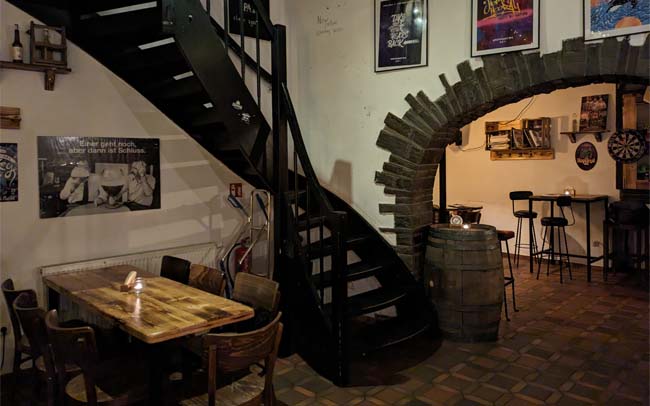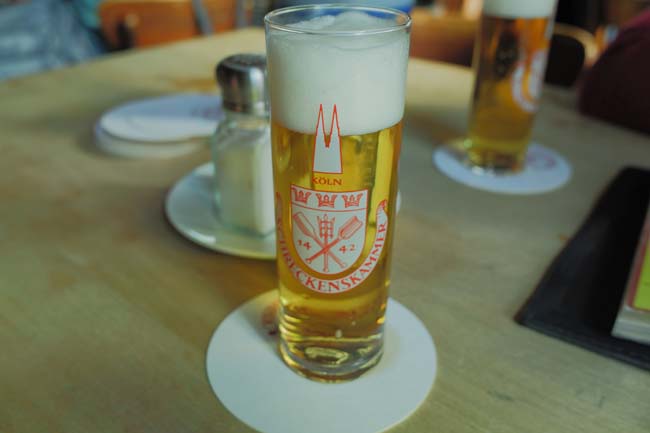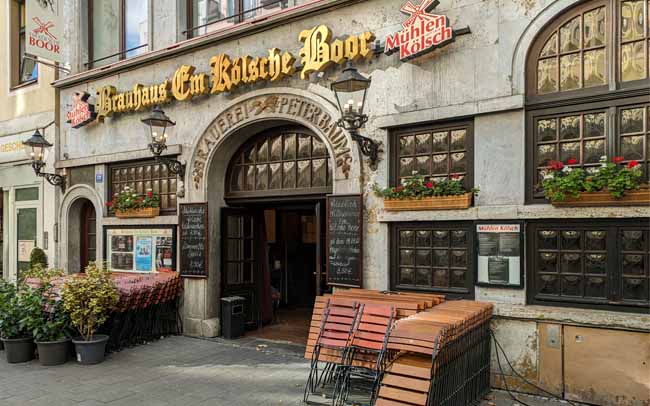Ads not shown when logged in
-
Automated Tracker

 Boak and Bailey's Beer Blog - Impressions of Köln: expansion pack
Boak and Bailey's Beer Blog - Impressions of Köln: expansion pack
Visit the Boak and Bailey's Beer Blog site
On our recent visit to Cologne we mostly ignored the Altstadt beer halls in favour of neighbourhood places, and found quite a different vibe.
We’re referring to this post as an expansion pack because it’s an extension of the one we wrote a year ago setting out our thoughts and feelings about Kölsch beer and Cologne drinking culture.
When we wrote that, a lot of people replied: “But you didn’t go to Lommi!”
And we said, relax, this won’t be our last visit to a city with which we’re increasingly enamoured.
 Lommi, or Gaststätte Lommerzheim, is an unlikely Cologne landmark. It’s on the wrong side of the river, in Deutz, a few streets back from any main road, surrounded by apartment blocks.
Lommi, or Gaststätte Lommerzheim, is an unlikely Cologne landmark. It’s on the wrong side of the river, in Deutz, a few streets back from any main road, surrounded by apartment blocks.
The building is out of step with its neighbours, being older, darker and more decayed. Forbidding signs warn of a broken step and issue instructions about queueing. Signs advertise Dortmunder Aktien Bier (DAB) – which, of course, the pub does not sell.
We’re going to call it a ‘pub’ because that’s what it feels like. We entered nervously, expecting to be directed by a waiter, or barked at, but instead found ourselves in an alleyway full of smokers who wouldn’t look out of place in Bridgwater or Bolton.
Eventually, we drifted towards the bar where nobody stopped us taking stools overlooking the service operation. And it’s what we’d call a machine.
Being a small place, with a small staff, it has to operate efficiently. So, glass washing is a big deal.
Our seats were in the splash zone for a big double sink with constantly trickling warm water (left) and cold water (right).
Dirty 200ml glasses would pile up on one side and every now and then a waiter with a spare moment would start washing them by:
- Grabbing two by their bases.
- Slamming them into the warm, soapy water.
- Working them up and down on two round wire brushes fixed in place.
- Dunking them in cold water.
- Stacking them to dry.
By our reckoning, they were able to wash 50 or so glasses in about a minute and a half. The secret being, perhaps, the knowledge that these apparently dainty, thin-walled glasses can take rougher handling than one might think.
The filling of the clean glasses was also highly efficient: they’re thrown or dropped into a Kranz (a circular tray with holes to hold glasses) which is then held under the tap of the wooden barrel and spun as golden Kölsch gushes in.
They kept bringing us beer and we kept watching the floor show as the pencil marks multiplied on our beer mat bill.
One waiter never smiled. The other never stopped laughing. After a while, we began to wonder if this was a coping mechanism, because he laughed hardest when the customers were being most obstructive and obtuse.
An older man with the air of a cowboy (perhaps a long-distance truck driver) alternated glasses of Kölsch and cigarettes in the courtyard.
Two burly lads ordered a Halve Hahn (cheese and a bread roll) and methodically dissected it so they’d both have a small cheese sandwich.
As the crowd thinned and the conversation became louder, and more sloppy, the laughing waiter passed through the bar with a plate of snacks. “Frikadelchen?” he shouted, waving their aroma over each table with a sheet of A4 paper.
 Früh em Veedel in Sudstadt doesn’t have the same reputation as Lommi but when we stayed nearby in 2022, we liked the look of it.
Früh em Veedel in Sudstadt doesn’t have the same reputation as Lommi but when we stayed nearby in 2022, we liked the look of it.
The problem was, we simply couldn’t get in last time round. It was always so busy we couldn’t even get through the door, or past the waiter on the door.
This time, we went on a quiet Wednesday afternoon figuring that, surely, they’d squeeze us in somewhere?
We almost got turned away again, even though it seemed to be empty, until Jess remembered the German for: “We don’t want to dine, we just want a drink.”
At which point, we were ushered through a previously unnoticed doorway into what people in the UK might call the public bar.
It had a couple of tall tables for leaning, two proper tables, and a row of what looked like garden benches.
Taking our lead from a couple of locals, we took a seat on a bench and waited about 4.5 seconds before Zwei Kölsch were delivered.
And that’s when we realised the benches were custom-made. There were circles cut in the arm rests, just the right size for Kölsch glasses, with a little suspended shelf below. This delighted us, as you can imagine.
Thereafter, it was almost self-service. You might get a visit from a waiter, if they noticed you were empty before you did. Otherwise, it was a matter of plonking your empty at the right spot on the gleaming bar and picking up fresh beer at the same spot.
It suited us, this less formal atmosphere, and we appreciated the peacefulness. The only sounds were the turning of the pages of a newspaper and the occasional conversation in concrete-thick Kölsch dialect between customers and barmen.
We didn’t need to be able to understand to get the gist: of course it’s all going to the dogs; of course something ought to be done, but it won’t; of course you can’t trust ‘em further than you can throw ‘em; but what can you do?
 The combined Sünner-Mühlen beer hall Brauwelt is way out of town in Kalk, a few stops on the tram from Lommi. It’s a fascinating place that got us thinking about the evolution of Kölsch.
The combined Sünner-Mühlen beer hall Brauwelt is way out of town in Kalk, a few stops on the tram from Lommi. It’s a fascinating place that got us thinking about the evolution of Kölsch.
The Zechen-Brauerei was built in the 19th century by Sünner. Fairly recently, Mühlen merged with, or took over, Sünner.
Now, both beers are produced on this site. Drays with both brands park in the yard. And both beers are available in the basement beer hall.
We wondered: is this the only place you can drink two different Kölschbiers side by side? It’s very much a tied-house town so this has to count as an oddity.
The great thing is that these particular beers, even if they’re from the same manufacturer, and produced on the same premises, offer a distinct contrast.
Sünner is like a crisp Pilsner, Mühlen is much more like a British ale, with an almost sulphurous nose and yeasty fruitiness.
The beer hall itself is interesting, too.
On our visit, the question “We just want a drink – is that OK?” prompted the response: “A drink? Here? In this establishment? How dare you! Nah, I’m messing with you, of course you can, let me find you a table…”
The staff, mostly women, were incredibly good natured and professional and indulged our weirdness in wanting both Kölschs at the same time.
Meanwhile, behind a curtain, another vast room was hosting a private party with a drag artist as the star turn.
It’s hard not to have fun when you can hear a hundred people stamping their feet and whooping with delight.
 For our next expedition, we jumped on a bus to the neighbourhood where Gilden’s brewery used to stand.
For our next expedition, we jumped on a bus to the neighbourhood where Gilden’s brewery used to stand.
Jess’s theory was that this would be a good place to get Gilden on draught, even if the brewery was gone, because the neighbourhood would still be loyal to the brand.
And she was right. We found a large beer hall in the ground floor of a post-war building absolutely covered in Gilden branding and calling itself, grandly, Gilden Brauhaus.
Was this perhaps part of the brewery complex? we wondered. Nope. Just an apartment block nearby.
Inside, we found a typical Cologne beer hall, done up to look like 1902 despite the exterior of the building being more like 1972.
It’s a restaurant, really, but “Zwei Kölsch” still worked as expected, and fresh beers came automatically, per tradition.
 Craft Beer Corner, which is in the city centre, but somewhat hidden, does not sell Kölsch. And we can hear the purists rolling their eyes from here. But hear us out.
Craft Beer Corner, which is in the city centre, but somewhat hidden, does not sell Kölsch. And we can hear the purists rolling their eyes from here. But hear us out.
We visited because, first, we were curious about how a craft beer bar in Cologne might differ from one in Bristol, and, secondly, because the owners seem like good eggs.
Last time we visited, they gave us loads of advice via social media without at any point doing the hard sell on their own establishment, which we really appreciated.
Our first observation was that it felt warmer and more gemütlich than the UK variant. The lights were low and there were plenty of dark corners.
The wall of fridges was present and correct, though, as was the row of keg fonts and accompanying blackboard menu.
There was another big, obvious difference there, though: the beers were mostly German, and included a range of traditional styles. Weizen Doppelbock, for example, and Bock. The closest to a Kölsch was a Wiess brewed for the bar by Ale-Mania in Bonn.
The barman switched to perfect English the moment he noticed our accents and gave us great advice on what to drink.
If we lived in Cologne, we suspect we’d be there a lot, in pursuit of something different. As it was, it felt too like home, and not enough like Cologne, so we drifted away after a couple of rounds.
 Schreckenskammer is on Ron Pattinson’s updated list. This was the guide we used on our first visit to Cologne, all those years ago, and it remains an essential resource.
Schreckenskammer is on Ron Pattinson’s updated list. This was the guide we used on our first visit to Cologne, all those years ago, and it remains an essential resource.
It’s not far out of the centre – perhaps a 10-minute walk from the cathedral and main station – but it is on the wrong side of the ring road, past a few building sites, garages and corner shops.
This barrier seems to insulate it from tourists, or at least English-speaking ones, and makes it feel ‘authentic’, whatever that means.
It’s a relatively small, cosy place, although in Cologne beer hall terms that still means it’s the size of, say, an interwar pub in a Birmingham suburb.
There’s a tiny standing bar at the front full of drinkers which, if we hadn’t wanted to eat, would have naturally appealed to us.
As it was, we headed to the bigger dining room full of families schnacking on schnitzels, including a priest, a party of academics, and a group of older women on a jolly day out from, we think, Wuppertal.
The house Kölsch is brewed for them, we think, at Früh through some arrangement with Dom (Radeberger) and is fine. A little sweet and corny, perhaps, but freshness sells it.
And it’s always thrilling to drink an orphan brand, in a timewarp setting.
 Finally, after Schreckenskammer, we pushed further out* into the neighbourhood north and east of the centre.
Finally, after Schreckenskammer, we pushed further out* into the neighbourhood north and east of the centre.
There were plenty of beer halls and pubs here, ranging from intriguingly scuzzy to rather grand.
We chose Brauhaus Em Kölsche Boor, a Mühlen place with history etched all over its impressive stone frontage.
The words “Brauerei Peter Baum” are carved over the door – a reminder of how many breweries Cologne has lost, like every other city in Europe.
Here, the boozing zone is upfront, with shelves and perches near the Kölsch barrel on the counter, while an apparently infinitely long dining hall stretches out beyond.
The boss man behind the counter had pompadour hair and a voice like a foghorn: “Zwei Kölsch?”
As he delivered beer to the Dutch couple canoodling in the window, the middle-aged man watching football on his phone, and the party of three lads in tracksuits, he sang a full-throated ‘Bella Ciao’.
“Prego,” he said, as he plonked down our beer.
“Grazie,” we said, confused.
“O bella ciao, bella ciao, bella ciao, ciao, ciao!” he replied, pinching his fingers in the air.
We’ve made many visits to Cologne now and we still feel as if we’re really only scratching the surface.
It’s a big city with plenty of neighbourhoods and suburbs to explore.
Might there be another Lommi or two lurking, round the back of a laundrette, near a discount supermarket, where the trams turn round?
Impressions of Köln: expansion pack originally posted at Boak & Bailey's Beer Blog
More...
Similar Threads
-
By Blog Tracker in forum Blog Tracker
Replies: 0
Last Post: 29-10-2023, 06:50
-
By Blog Tracker in forum Blog Tracker
Replies: 0
Last Post: 12-09-2019, 20:03
-
By Blog Tracker in forum Blog Tracker
Replies: 0
Last Post: 30-01-2019, 21:54
-
By Blog Tracker in forum Blog Tracker
Replies: 0
Last Post: 21-06-2016, 10:49
-
By Blog Tracker in forum Blog Tracker
Replies: 0
Last Post: 20-06-2016, 10:51
 Posting Permissions
Posting Permissions
- You may not post new threads
- You may not post replies
- You may not post attachments
- You may not edit your posts
-
Forum Rules
Lommi, or Gaststätte Lommerzheim, is an unlikely Cologne landmark. It’s on the wrong side of the river, in Deutz, a few streets back from any main road, surrounded by apartment blocks.
Früh em Veedel in Sudstadt doesn’t have the same reputation as Lommi but when we stayed nearby in 2022, we liked the look of it.
The combined Sünner-Mühlen beer hall Brauwelt is way out of town in Kalk, a few stops on the tram from Lommi. It’s a fascinating place that got us thinking about the evolution of Kölsch.
For our next expedition, we jumped on a bus to the neighbourhood where Gilden’s brewery used to stand.
Craft Beer Corner, which is in the city centre, but somewhat hidden, does not sell Kölsch. And we can hear the purists rolling their eyes from here. But hear us out.
Schreckenskammer is on Ron Pattinson’s updated list. This was the guide we used on our first visit to Cologne, all those years ago, and it remains an essential resource.
Finally, after Schreckenskammer, we pushed further out* into the neighbourhood north and east of the centre.




 Reply With Quote
Reply With Quote